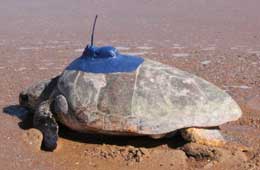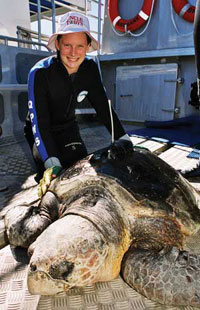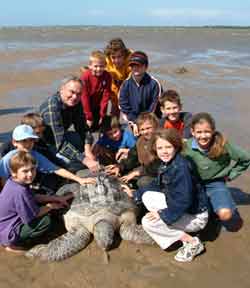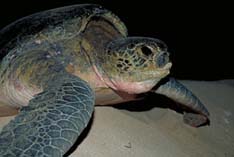Turtle tracking research program
Queensland’s loggerhead turtle research program has been running for more than 40 years, focusing on the Mon Repos turtle rookery near Bundaberg.
Satellite tracking has been used a number of times, but the latest next generation tags used in the current program provide much more accurate data that previous technology.
The new GPS satellite tags are attached to the back of each turtle and determine the latitude and longitude location when the turtle surfaces for a breath. The resulting data provides vital information about turtle migratory patterns and breeding habits.
In the summer of 2010, three female loggerhead turtles were tracked along the southern Queensland coast. The data revealed that these small creatures travelled long distances over a five-month period.
These tags only work for a limited amount of time. In the video below where the turtle appears to have ceased moving, the tracker has either fallen off or failed.

Leonie the loggerhead
Leonie is a turtle that researchers have been following for about 14 years. Researchers estimate that Leonie is in her mid-40s and she returns to Mon Repos every couple of years for the breeding season from her home feeding ground in Moreton Bay.
Leonie was one of the turtles tracked during the summer of 2010 before her satellite tag fell off (the red turtle path in the video above).
In December 2011, Leonie returned to Mon Repos and researchers attached a new satellite tag to her. It is hoped this will provide insight into what habitat she uses in a post-flood environment.
Researchers will then be able to compare her movements with her pre-flood habits, giving a first-hand glimpse into how the turtle population is adapting to the consequences of the 2011 floods.

Premiere makes her debut
In December 2003, turtle researchers were excited that a very special turtle arrived to nest at Mon Repos Beach near Bundaberg. This turtle, named ‘Premiere’ was the first of the 7381 loggerhead hatchlings tagged in early 1975 to return to a nesting beach as a breeding adult.
They named her Premiere and over the summer of 2003-04, she came ashore four times at Mon Repos and laid four clutches of eggs. Two other loggerheads tagged in 1975 also turned up and laid clutches that season.
In late December 2003, researchers fitted Premiere with a radio tag and released her for tracking studies. They want to work out the home range for a loggerhead during the nesting period, the path of her migration after nesting, and her home range outside nesting time.
Premiere laid her final clutch for the season 19 days after the tag was fitted, then left the Mon Repos area on 15 January 2004. She moved north about 416 km in just 16 days to the Percy Isles north of Shoalwater Bay. By 10 March she was 1426 km north of Mon Repos off Howick Island near Lizard Island, but her swimming appeared to be slowing down.

Jimmy's journey
In May 2003, Jimmy the turtle joined Moreton, Dean the Green and Ted on their journeys while being tracked via satellite.
Jimmy is an adult male loggerhead turtle who weighs 105 kg. He was caught by Queensland Parks and Wildlife Service scientists in southern Moreton Bay on 20 May 2003. They glued a radio transmitter to his shell.
Jimmy was named by Olympic swimmer Leisel Jones, after her late grandfather. Leisel joined the research team during the annual turtle survey in Moreton Bay and even helped catch some turtles!
She was amazed that sea turtles can swim as fast as a swimmer doing training laps, but for days at a time, not just hours.
Jimmy was first captured and tagged with a metal ID tag back in 1991 in Moreton Bay while feeding. He was seen again in 1996 and 1998, then again in 2003.
He was one of a series of six adult male loggerheads in Moreton Bay fitted with radio transmitters. He was not preparing to breed in 2003, and scientists hope to find out whether non-breeding males have a similar sized home rang to that of males preparing for a breeding season.
Jimmy left the bay a couple of weeks after being fitted with his transmitter and headed for Flat Rock off North Stradbroke Island. His transmitter was sending strong signals.

Moreton's marvellous migration
In September 2002, Moreton the Turtle joined Dean the Green and Ted on their migration journeys while being tracked via satellite.
Moreton is a mature male green turtle who weighs nearly 140 kg. He was caught by Queensland Parks and Wildlife Service scientists near Moreton Island. They glued a radio transmitter to his shell, to help them follow Moreton's movements.
He was named by Josiah Hayton, aged 7, and Lana Mansfield, aged 11. They were among more than 300 school children who entered a competition to name the turtle. Judges had to make a tough choice from the many inspired entries!
One reason the judges liked the name is because Moreton Bay is an important feeding ground for green turtles.
On 13 September 2002 at Cleveland, Josiah and Lana helped then Environment Minister Dean Wells, QPWS scientists and local community members to release the turtle and watched him swim off strongly into Moreton Bay. QPWS expected to track Moreton in his feeding grounds until he moved out of the bay on a breeding migration.

Ted the Turtle
Ted is a 138 kg adult male green turtle with big shoes to fill. He was the successor to the famous Dean the Green who was tracked wandering the Southern Pacific Ocean off the Queensland coast for two months. Find out more about Dean the Green below.
Ted the Turtle was released on 24 August 2002 at Deception Bay. Ted was named after the turtle exclusion devices used by trawlers to prevent turtles drowning in trawl nets.
Watch Ted's trek as he moves from his feeding grounds in Moreton Bay Marine Park to breeding grounds, possibly between K'gari (formerly Fraser Island) and the southern Great Barrier Reef, by monitoring the Ted the Turtle trek site.
Dr Col Limpus, head of the Queensland Turtle Research Program, said: "The information QPWS hoped to receive from the tracking device would build on the data we already had obtained about seafaring habits of green turtles."
"The transmitter, which does not harm Ted, is stuck to his shell and is about the size of a paperback novel, with an antenna about 15cm long and 1cm in diameter. Seaworld has sponsored Ted's tracking device," he said.
Ted was the second of four adult male green turtles that QPWS planned to fit with radio transmitters to track turtles' breeding migrations via satellite.
Scientists released a third turtle in September and QPWS invited Queensland schoolchildren to name the turtle which would follow Dean and Ted's excellent adventures. He was called 'Moreton'.

Dean the Green turtle
For two months from 6 June 2002 we followed "Dean the Green" on his migrations from his feeding grounds in Moreton Bay, southern Queensland. Dean the Green is an adult male green turtle Chelonia mydas. The massive animal has a shell more than 105 cm across and is likely to be more than 40 years old. He was preparing to breed in the spring of 2002.
On 6 June 2002 during the annual Moreton Bay turtle survey, researchers from the Queensland Parks and Wildlife Service fitted Dean with a transmitter about the size of a paperback novel, as part of the Queensland Turtle Conservation Program.
Dr Col Limpus, head of the research program, said "the transmitter was sponsored by Seaworld Research and Rescue Foundation on Queensland's Gold Coast, and sent signals to a satellite so we could track Dean's movements. Every three or four days we updated Dean's progress on this web page."

"We had expected him to stay in his feeding grounds through winter and move north to breeding grounds in mid to late September. We don't know why he headed out of Moreton Bay so early. Perhaps the water became too cold or food too scarce, or his foraging area is much larger than the Bay. "His trek has expanded our knowledge of migration paths - we can look at how these animals' movements intersect with areas where they face high risk of mortality, such as trawling and long-line fisheries known to impact on turtles."
"We had hoped Dean would help us answer other questions such as:
- What is his home range in the Bay?
- What path does he take to his courtship area, and how long does he take?
- What's the home range of his courtship area? How long does he spend there?
- Where does he go after breeding? Will he come back to the same spot in Moreton Bay?"
Signals from Dean the Green's satellite transmitter stopped on 5 August 2002. The most likely cause was electronic equipment failure. This is not necessarily the last we have heard from Dean the Green. Turtle researchers are looking for him, and want the public to report any sightings of this now-famous turtle with the distinctive transmitter on his back. Call the RSPCA Qld to report any sightings.

Dean's travels
After tagging and release on 6 June 2002, Dean stayed near the bottom of Moreton Island for about five weeks, feeding in seagrass beds. On 10 July, he suddenly left the Bay and swam out into the Pacific. Dean crossed the continental shelf, and by 18 July he was 290km north-east of Moreton Bay.
He then stayed in deep oceanic waters, and at 30 July he was about 150km east of K'gari and heading north. He then headed west and the last readings were on 5 August 2002, when he was just off Waddy Point, K'gari.


